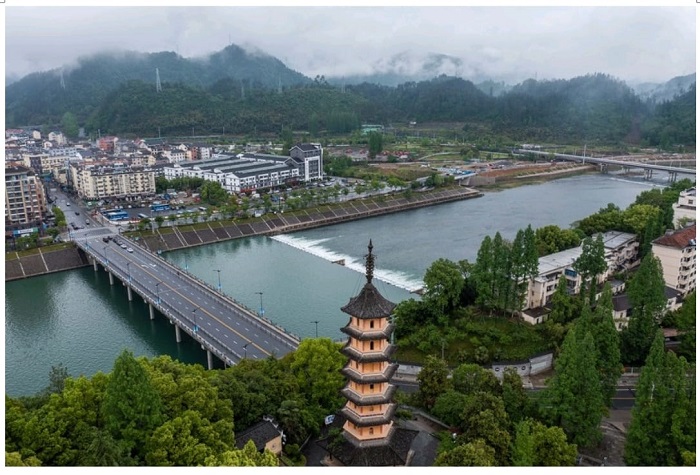
Fashion designer Chu Yan's studio is decked with sets of traditional Chinese robes, one of which made its mark in the Beijing Winter Olympics.
Chu is known for her work in recreating traditional Chinese garments and adding a modern twist to ancient elements. She also teaches at the Beijing Institute of Fashion Technology and runs her own studio.
Blending "Bao Xiang Hua," a hybrid floral pattern once commonly found in ancient ceramics, and images of snowflakes, she worked on designs for the medal ceremony of the Beijing Winter Olympics, an international stage which she believes can "bring modern Chinese aesthetic to the world."
"I found great joy in reading about fashion in a magazine when I was only 12 and set my life target on becoming a designer," she said. Having extensively studied fashion from different countries, she developed a keen interest in traditional Chinese garments.
Chu's career has thus thrived in the last decade, banking on a surge in the popularity of domestic brands and products that incorporate traditional Chinese style and culture, a trend known as "guochao," or China Chic.
"The new generation of designers shall aim high, not merely showing the Chinese beauty to the world, but also aiming to lead global fashion," she said.
CHANGES FOR THE BETTER
A decade fleets by, and much has changed in what the Chinese people wear. Shops selling high couture have no shortage of generous buyers. Adding to the long-lasting glamor list of Qipao (robes) and Tang suits is Hanfu, a type of traditional garment.
Data from iiMedia Research shows Hanfu sales climbed from 190 million yuan (26.76 million U.S. dollars) to 6.36 billion yuan from 2015 to 2020 in trends advanced by social media influencers and live streamers who look like they have stepped out of a set of a historical drama.
"What's seen now is a modern renaissance flourishing on the rich soil of traditional Chinese culture. The garment industry will definitely see more original and ingenious creations," said Wang Wensheng, vice director of the Beijing textile and garment association.
China's GDP doubled to 114 trillion yuan last year from over 50 trillion yuan in 2012. Ten years ago, China's per capita GDP was 6,300 U.S. dollars, which climbed to over 12,000 U.S. dollars last year. Deeper pockets are sustaining more diverse choices.
Zhang Yanmei, who works with the hotpot chain of Xiabu Xiabu, recounts the changes in the hotpot broths. "A few years back, there were not as many flavors. Now we have Thai Tom Yum Kung flavor, Indian curry flavor, and even durian chicken flavor, and almost all can be delivered to your doorstep," she said.
New brands and chains have kept emerging in the catering industry, and businesses are expanding overseas, she added.
Looking back over the past decade, the way of traveling or getting around is also changing. Zhao Qirong, a resident of Taiyuan, capital of north China's coal-rich Shanxi Province, has witnessed the rapid growth of electric cars. By June this year, China had 10 million new energy vehicles. Zhao has also bought an electric car for his wife to commute and take his kid to school. "Many people are buying electric cars. They are quite convenient," he said.
High-speed railway is another transportation field that is developing by leaps and bounds. "Chinese high-speed railway technology is breaking new boundaries to benefit the public," said Gao Liang, chief of the School of Civil Engineering, Beijing Jiaotong University. By the end of 2021, China's total length of railways and highways had increased by 1.1 million km from 2012, data showed.
CODE TO GROWTH
The past decade has been driven by innovative, coordinated, green, open, and shared development, which has brought profound changes in the social and economic life in China, said Gu Hailiang, a professor at Peking University.
"Through the comprehensive and faithful implementation of the concept, China will further advance high-quality growth and raise competitiveness," he said.
Facing the pandemic, China posted a 2.5 percent year-on-year growth from January to June this year and is on track for further recovery. Since 2012, about 100 million rural residents in China have emerged from absolute destitution. Among the massive tasks completed were 9.6 million people resettling from less inhabitable areas to areas with a better environment.
China's anti-poverty feat has made its mark in the history of humanity, reflecting the strength of Party leadership, the efficacy of its people-centered philosophy, and its institutional strength, observers say.
In its Outline of the 14th Five-Year Plan (2021-2025) for National Economic and Social Development and the Long-Range Objectives Through the Year 2035, China has reiterated its commitment to the people-centered approach for the years to come, insisting that the development is for the people and depends on the people, and that its fruits are shared by the people.
Going forward, China has also set out new development goals and put common prosperity in a more prominent position, aiming at affluence shared by everyone.
Zhejiang Province, which is a demonstration zone for achieving common prosperity, is making steady headway, said Yu Jianxing, president of Zhejiang Gongshang University.
"Zhejiang's practices are helping us deepen understanding of what it means to realize common prosperity, and it is laying the groundwork for achieving the target," he said.